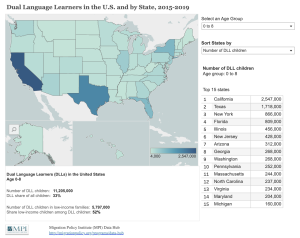4-1 Demographics and Trends
Before we begin talking about how language develops for children who are multilingual learners, let’s take a closer look at characteristics, demographics, and trends that distinguish them. The better we can understand where our students come from, the better we’ll be able to understand their development.
First, it’s essential to recognize that significant variability exists among children who are multilingual learners and their families. We can’t assume that just because a child is from a “Spanish-speaking home,” they don’t understand or use any other languages.
For example, in a nationally representative sample of Latino/a infants, Barrueco, Lopez, & Miles (2007) found:
- 19% lived in a home where only Spanish was spoken.
- 35% were exposed to primarily Spanish and to some English.
- 22% were exposed to primarily English and to some Spanish.
- 21% lived in homes where only English was spoken.
Just because there may be several children in our early childhood program whose families come from the same country, or even the same region or town within the same country, each child and family is different and unique. Each family has its own set of experiences and values which shape their culture. And, as we well know, each child is certainly an individual with his or her own interests, temperament, and abilities.
In the words of an Early Head Start teacher:
“I see a lot of differences in language and customs among Mexican immigrant families depending on the region they are from, their socio-economic background, highest level of education, and whether they were in a rural or urban setting. I have worked with some families that are from rural areas where they grew up as MLLs, first learning an indigenous language such as Nahuatl, Mixteco, etc, and then learning Spanish.”
Using data from the U.S. Census Bureau for the years 2015-2019, the Migration Policy Institute reports that 33 percent of children in the United States ages 0-8 are dual language learners. In California, 60 percent of children ages 0-8 are considered dual language learners. That’s the highest percentage in the U.S. In total, there are approximately 11 million students who are multilingual learners.

 There are significant, growing numbers of multilingual learners in the United States, signaling the necessity for culturally sustaining educators who are willing and prepared to support children who are multilingual learners in their classrooms.
There are significant, growing numbers of multilingual learners in the United States, signaling the necessity for culturally sustaining educators who are willing and prepared to support children who are multilingual learners in their classrooms.
Considering statistics that the majority of children who are multilingual learners are born in the United States, and that most children who are multilingual learners have at least one parent who was not, educators must recognize the experiences of many children who are part of two or more national cultures.
Additionally, children of color who are multilingual learners face the adversity of racial oppression in relation to immigration status in a country that has both a history and a current structure of societal values that promote exclusion of non-white immigrants.
References
Barruco, S., Lopez. M., & Miles, J. (2007). Parenting behaviors in the first year of life: A national examination of Latinos and other cultural groups. Latinos and Education, 6(3), 253-265.
Migration Policy Institute (2015-2019). Young dual language learners in the United States and by state. [Website].
U.S. Department of Education, National Center for Education Statistics, Common Core of Data (CCD), Local Education Agency Universe Survey, 2015–16. See Digest of Education Statistics 2017, table 204.20. [Website]
Zong, J. & Batalova, J. (2015). The limited English proficient population in the United States. [Online Article]
Cite this Source:
EarlyEdU Alliance (Publisher). (2019). Demographics and Trends. In Supporting Multilngual Learners Course Book. University of Washington. [UW Pressbooks]

